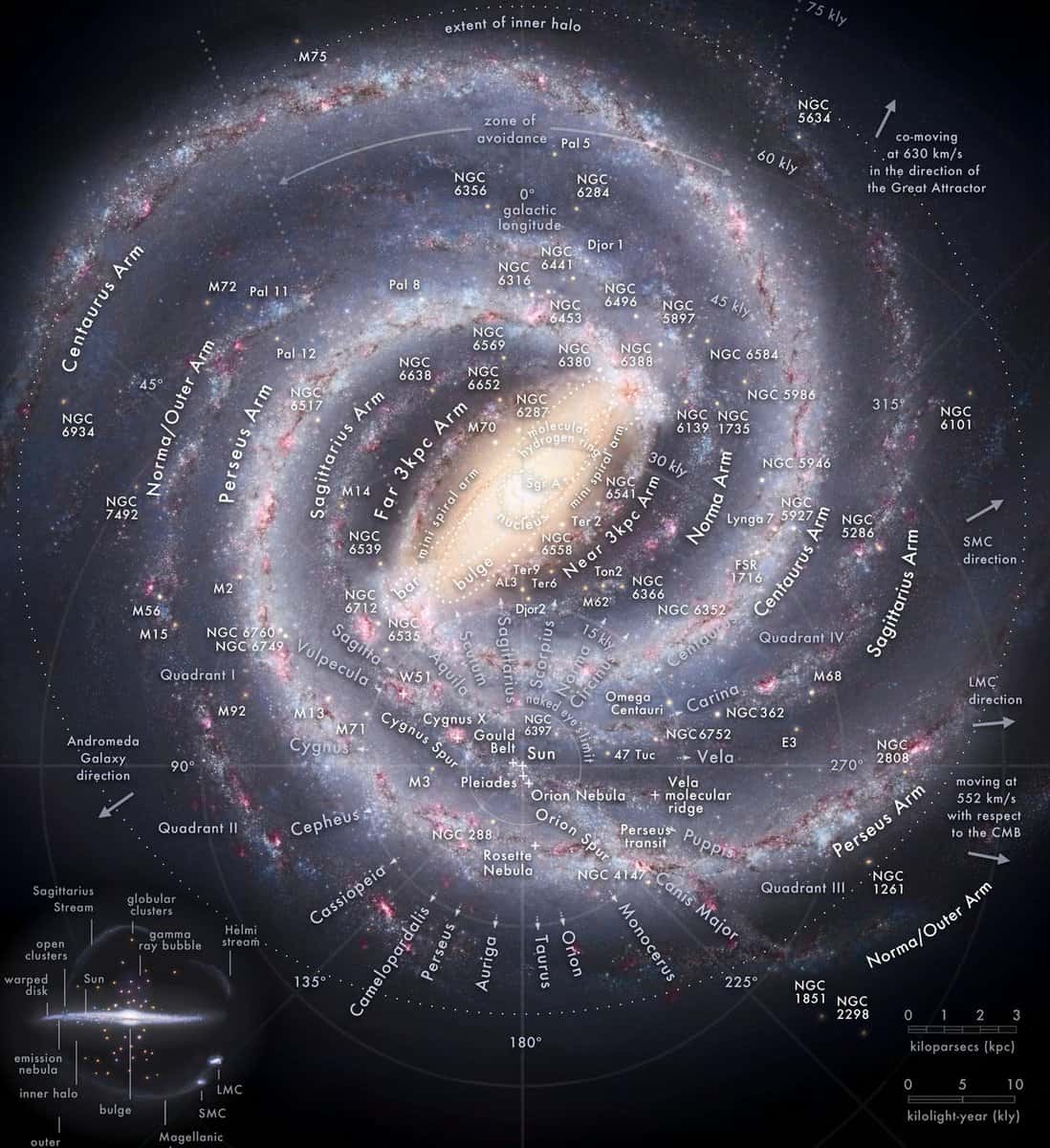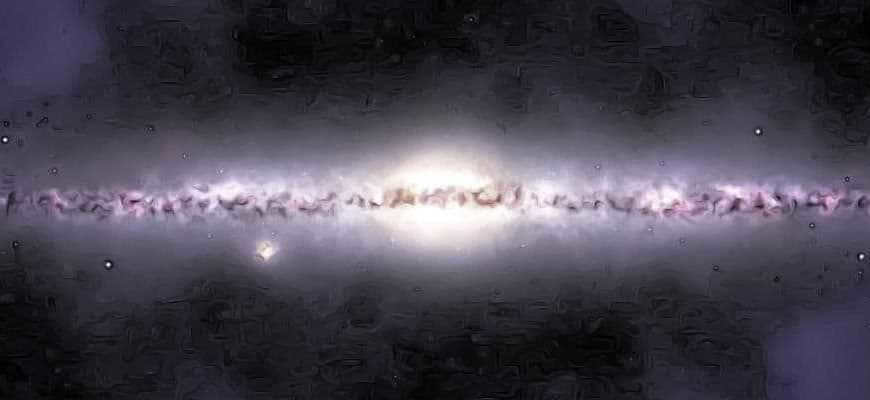
If you have ever had the opportunity to spend a night under the open sky, you would have undoubtedly been treated to a captivating phenomenon: a luminous white band stretching across the entire expanse… This celestial marvel is none other than our very own galaxy – the Milky Way. The Milky Way.…
The galaxy The Milky Way
In 1785, Sir William Herschel attempted to determine the shape of The Milky Way by observing the stars. However, he was unaware that gas and dust concealed the majority of the galaxy, leaving its true form a mystery. It wasn’t until 1610 that it was proven that The Milky Way consists of numerous stars. It was only with the help of more advanced telescopes that astronomers discovered the abundance of stars in the sky. They also realized that nearly everything visible in the sky is part of The Milky Way.
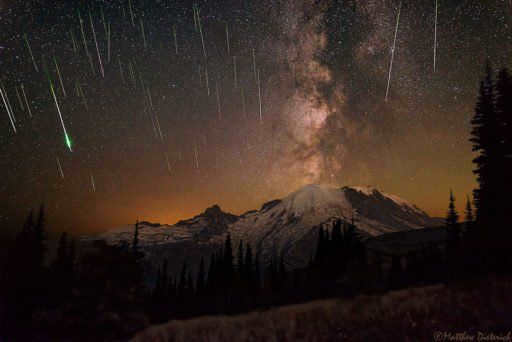
Until 1920, no new information had been discovered regarding the characteristics of the Milky Way. However, in that year, astronomer Edwin Hubble presented compelling evidence that the spiral nebulae visible in the sky were actually separate galaxies. This revelation established the true structure of our Galaxy and provided astronomers with a greater understanding of its spiral nature. Additionally, it allowed them to gain insight into the vastness of the Universe.
The Structure and Composition of the Milky Way Galaxy
Picture yourself soaring hundreds of thousands of light years away in a direction perpendicular to the plane of the Milky Way’s disk. From this vantage point above, you would observe that our galaxy is a spiral galaxy with gaps between its arms. The Milky Way spans approximately 120,000 light years in diameter and is about 1,000 light years thick. Previously, scientists believed that our galaxy possessed four primary spiral arms. However, recent research has unveiled that there are actually only two main arms, namely the Escudo-Centauro and Carina-Sagitario arms. Additionally, there are secondary arms, one of which houses our very own Sun.
When we look up at the night sky, the galactic center of our Galaxy appears much brighter. This is because the Milky Way splits the sky into two approximately equal halves, suggesting that our solar system is positioned near the Galactic plane. The presence of gases and dust in the galactic disk contributes to the relatively low brightness of the Milky Way, making it difficult for us to see the radiant core of our Galaxy. Additionally, this obscures our view of the celestial objects on the opposite side of the galaxy.
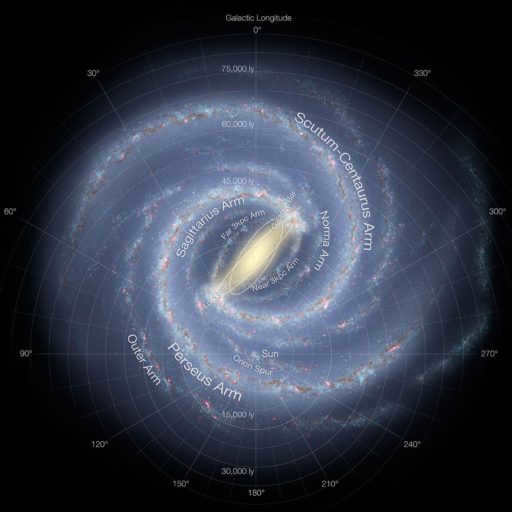
The center of the Milky Way is located in which constellation? Spiral arms are regions of high-density material that revolve around the core of our galaxy. As they traverse through space, they compress dust and gas that intersect their path, resulting in active star formation. At the heart of our galaxy lies an enormous black hole known as Sgr A*. This colossal black hole possesses a mass that is 4 million times greater than that of our Sun.
The position of our solar system
Similar to other stars in the Milky Way Galaxy, our star revolves around a black hole. It takes approximately 240 million years for the Solar System to complete one orbit around the center of the Milky Way Galaxy. This time span is known as a galactic year among astronomers. Consider this – the last time the Sun was in its current region of space, dinosaurs ruled the Earth’s surface. Since its formation, the Sun has completed fewer than twenty orbits around the center of the Galaxy.
The solar system is situated in the Orion arm, which is the area of space between the two major arms of our Galaxy mentioned earlier. This is where we call home – in this comfortable corner of the Milky Way. The distance from the solar system to the center of our galaxy is estimated to be about 27,000 light years.
If we compare the method of counting years to the way people count their years, it can be said that the Sun came into existence approximately 18 years ago. Similarly, the Big Bang, which resulted in the creation of the Universe, is still quite young, with an age of only 61 galactic years, rather than the commonly known 14 billion years. However, it is worth mentioning that this particular time measurement is not widely utilized, as it would result in the age of human civilization being expressed in galactic minutes, if not seconds.
What lies ahead for the Milky Way?
In the far distant future, the Milky Way is set to have a dramatic encounter with the Andromeda Galaxy. These immense celestial bodies will ultimately combine, resulting in the formation of an even grander elliptical galaxy. The convergence of the two galaxies will also bring together their supermassive black holes, ultimately forming an even more massive black hole. Despite the potential magnitude of this event, it is unlikely to have a significant impact on the stars within the Milky Way. Based on simulations, it is predicted that our solar system will remain unaffected by the merger. The chances of being expelled from the newly formed galaxy are exceedingly small, bordering on insignificance. As for the timeline of this cataclysmic event, the collision between the Milky Way and the Andromeda galaxy is expected to occur approximately 4 billion years from now.
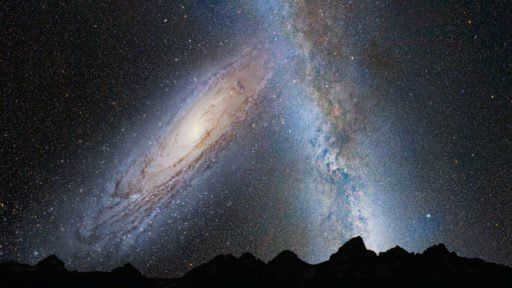
Satellites of the Milky Way
The Milky Way possesses satellite galaxies. They are smaller in size compared to ours, but some of them are renowned. Among them, the Small and Large Magellanic Clouds stand out. These entities can only be observed in the southern hemisphere of our planet. They are located at a distance of 199,000 and 158,000 light-years from Earth, respectively. There are also other satellite galaxies, such as the dwarf elliptical galaxy in Sagittarius, which is even closer to us at approximately 50,000 light-years away.
The Local Group, which includes the Milky Way and Andromeda, is a component of a larger assemblage of galaxies known as the Virgo Supergroup. This remarkable region of space showcases an astounding concentration of galaxies. Spanning approximately 110 million light years in diameter, the Virgo Supergroup is not the ultimate boundary. It is, in fact, a constituent of the Laniakea galactic filament, which boasts a diameter of 520 million light years.
However, the Laniakea galactic filament is merely a fraction of an even grander entity….
When you gaze up at the night sky, you will notice a faintly glowing whitish band that stretches across the entire celestial sphere. This soft radiance is a result of the combined light emitted by several hundred billion stars as well as the diffused light scattering off minuscule particles of gas and dust in the vast expanse of interstellar space. This celestial wonder is none other than our very own Milky Way galaxy, the galactic home to our Solar System and its collection of planets, including our beloved Earth. The Milky Way can be observed from any point on the Earth’s surface, captivating our imaginations with its majestic ring-like structure. However, it’s important to note that our view of the Milky Way is limited to only a fraction of its entirety due to its vast size. Although the Milky Way appears as a dim, glowing pathway, it is in fact composed of an immense number of stars that are invisible to the naked eye when observed individually. It was Galileo Galilei, the renowned scientist of the early 17th century, who first contemplated this phenomenon when he turned his telescope towards the Milky Way. What he beheld was truly awe-inspiring. In place of the expansive white streak, Galileo witnessed dazzling clusters of stars, each one visible to the naked eye. Modern-day scientists have estimated that the Milky Way is home to an astonishing 200 billion stars.
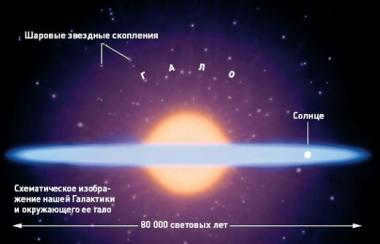
Figure 1 depicts the arrangement of our Galaxy and the halo that surrounds it.
The Milky Way is a spiral galaxy that encompasses a vast, flat main body in the form of a disk, with a diameter exceeding 100,000 light-years. The disk of the Milky Way is “relatively thin,” measuring several thousand light-years in thickness. Most of the stars are concentrated within this disk. The disk’s morphology is intricate, featuring irregular structures that extend from the core to the Galaxy’s outer edges. These structures are known as the spiral arms, which are high-density regions where new stars form from interstellar dust and gas clouds.
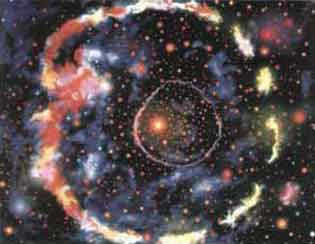
Fig. 2 The center of the Galaxy. Image displaying the central region of the Milky Way in traditional colors.
Explanation of the Image: The central region features Sagittarius A, which is a highly active star-forming area situated near the galactic core. The center is surrounded by a ring of ionized gas (pink circle), while the outer ring consists of molecular clouds (orange) and the ionized hydrogen present in the pink-colored space.
Located in the core of the Milky Way’s disk lies the galactic center. Comprising of billions of aging stars, the center is a highly dense region spanning a mere few light years in diameter. Recent astronomical investigations have revealed the presence of a supermassive black hole, potentially multiple black holes, within this central core. These black holes boast a mass equivalent to approximately 3 million suns.
Around our Galaxy, there exists a spherical halo known as the corona. This corona is home to various celestial objects such as dwarf galaxies, including the Large and Small Magellanic Clouds, as well as globular star clusters, individual stars, star groups, and hot gas. Some of these star groups interact with globular clusters and dwarf galaxies. Analyzing the structure of the halo and the trajectories of star clusters, scientists have hypothesized that both globular clusters and the galactic corona itself could be remnants of former satellite galaxies that were absorbed by our Galaxy due to past interactions and collisions.
Furthermore, scientific speculation suggests that our Galaxy contains dark matter, which could potentially be more abundant than all visible matter across all observational ranges.
Dense gas regions, spanning several thousand light years and having a temperature of 10,000 degrees Celsius, as well as a mass equivalent to 10 million Suns, have been discovered in the outer regions of the Galaxy.
Our Sun is situated close to the galactic disk, approximately 28,000 light years away from the center of the Galaxy. To put it differently, it is positioned on the outskirts, at a distance of nearly 2/3 of the galactic radius from the center, which amounts to roughly 8 kiloparsecs from the Galaxy’s center.
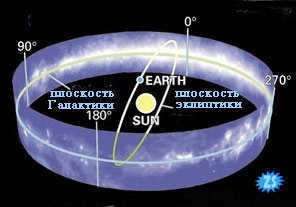
Figure 3 shows that the plane of the Galaxy and the plane of the Solar System do not align perfectly but are tilted relative to each other.
You have just finished listening to the initial segment of the article: Our Galaxy – Milky Way –>
The Sun’s Position in the Galaxy
We provide a detailed discussion on the position and motion of the Sun in the Galaxy in the dedicated Sun section of our website (refer to The position of the Sun in the Milky Way Galaxy). The Sun completes a full revolution in approximately 250 million years (some sources suggest 220 million years), constituting a galactic year. Remarkably, the Sun’s motion speed is 220 km/s, equivalent to almost 800,000 km/h! Every 33 million years, the Sun crosses the galactic equator, subsequently ascending above its plane to an altitude of 230 light-years before descending back down to the equator. As previously mentioned, it takes the Sun about 250 million years to accomplish a complete revolution.
As we observe the Galaxy from within its boundaries, the celestial sphere reveals its disk as a stunning array of stars, forming what we know as the Milky Way. Consequently, accurately discerning the true three-dimensional layout of our galaxy from our vantage point on Earth proves to be a formidable task.
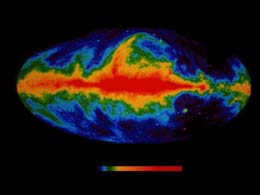
Figure 4 provides an overview of the entire sky in galactic coordinates, obtained at a frequency of 408 MHz (wavelength 73 cm), and presented in conventional colors.
The map displays the radio intensity using a linear color scale, ranging from dark blue (indicating the lowest intensity) to red (representing the highest intensity). The resolution of the map is approximately 2 degrees. Numerous well-known radio sources can be observed along the galaxy plane, including the remnants of Cassiopeia A and the Crab Nebula.
Notably, there are clearly distinguishable complexes of local arms (Swan X and Sails X) that are surrounded by diffuse radio emission. This diffuse radio emission in the Milky Way primarily originates from synchrotron radiation produced by cosmic ray electrons interacting with the galaxy’s magnetic field.
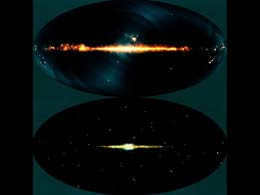

Figure 5 showcases two comprehensive images of the entire sky, which were constructed using data obtained from the 1990 DIRBE Diffuse Infrared Background Experiment conducted on the COBE satellite.
Both images exhibit prominent emissions originating from the Milky Way. The upper photograph depicts the combined emission data captured at far-infrared wavelengths of 25, 60, and 100 microns, represented by the colors blue, green, and red respectively. This emission primarily stems from cold interstellar dust. The pale blue background radiation, on the other hand, results from interplanetary dust within our own solar system. The lower image, on the other hand, combines emission data captured at near-infrared wavelengths of 1.2, 2.2, and 3.4 microns, represented by the colors blue, green, and red respectively.
A fresh depiction of the Milky Way
The Milky Way falls into the category of a spiral galaxy. As previously mentioned, it is composed of a central body in the form of a flat disk with a diameter exceeding 100,000 light-years, housing the majority of stars. The disk displays a non-uniform structure, with irregular patterns evident from the core to the outer regions of the Galaxy. These patterns form the spiral arms, which are regions of high matter density and serve as hotspots for the formation of new stars. This process initiates within interstellar gas and dust clouds. The cause of the spiral arms remains unknown, although numerical simulations of galaxy formation consistently predict their presence when there is sufficient mass and rotational momentum.
A digitally generated 3D representation of the Milky Way displaying the precise positions of numerous nebulae and stars.
© National Geographic Society, Washington D.C. 2005.
Take a careful examination of it. –>
Galactic Components in Motion
Different components of a galaxy exhibit varying velocities as they orbit its central axis. If observed from an aerial perspective, we would observe a densely populated and luminous core with stars in close proximity, as well as spiral arms where stars are dispersed in a less compact manner.
The rotation of the Milky Way, and other spiral galaxies, causes the spiral arms to appear twisted. It is important to note a specific point. Over the course of the Galaxy’s existence (at least 12 billion years, according to current estimates), the spiral arms should have twisted around the galaxy’s center multiple times. However, this phenomenon is not observed in our galaxy or others. In 1964, C. Lin and F. Shu proposed a theory that suggests the spiral arms are not physical formations, but rather density waves that stand out against the galaxy’s flat background. These waves are primarily visible due to the active star formation within them, resulting in the birth of highly luminous stars. The rotation of the spiral arm is unrelated to the motion of stars in galactic orbits. Close to the galactic nucleus, stars have orbital velocities that exceed the speed of the arm, causing them to “flow” into the arm from the inside and exit from the outside. At larger distances, the opposite occurs: the arm appears to catch up to the stars, temporarily incorporating them before moving past them. The bright OB stars that define the spiral pattern are born within the arm and typically do not leave during their relatively short lifetimes.
The gas ring and the movement of stars
As per one theory about the Milky Way’s structure, there exists a “gas ring” between the Galactic center and the spiral arms. This gas ring contains billions of solar masses of gas and dust and serves as a hub for active star formation. The gas ring emits strong signals in both radio and infrared wavelengths. Researchers have studied this formation by examining gas and dust clouds along the line of sight, but determining precise distances and configuration has proven challenging. Consequently, there are currently two main viewpoints among scientists. The first posits that the formation consists of grouped spirals rather than a singular ring. The alternative perspective suggests that it can indeed be considered a ring. It is believed that this formation is located at a distance of 10 to 16 thousand light years from the Galactic center.
There exists a specialized area of astrophysics that focuses on studying the movement of stars within the Milky Way, known as “stellar kinematics.”
In order to simplify the study of stellar kinematics, stars are categorized into different groups based on certain characteristics, such as age, physical attributes, and their position within the Galaxy. The majority of young stars, which are primarily found in the spiral arms, have rotational velocities of a few kilometers per second in relation to the Galaxy’s center. It is believed that these stars have not had enough time to interact with other stars and thus have not experienced the mutual attraction that would increase their rotational speed. On the other hand, middle-aged stars tend to have higher velocities.
The fastest-moving stars are typically found in the old, spherical halo that surrounds our Galaxy, extending up to 100,000 light years from the center. These stars can reach speeds exceeding 100 km/s, similar to those observed in globular star clusters.
Within the inner regions of the Galaxy, where stars are densely concentrated, the motion of the Galaxy presents itself in a manner akin to that of a solid entity. In these areas, the rate of rotation for stars is directly proportionate to their distance from the central point. Consequently, the rotation curve will assume a linear form.
On the other hand, in the outer periphery, the motion of the Galaxy no longer resembles that of a solid body. This particular region is not adequately populated with celestial bodies. As a result, the rotation curve for these peripheral regions will exhibit a “Keplerian” nature, similar to the principle governing the varying speeds of planets within the solar system. The rate of rotation for stars diminishes as they traverse further from the central point of the galaxy.
Clusters of stars
Not only stars, but also other celestial objects that inhabit the Milky Way are constantly in motion: these include scattered and globular star clusters, nebulae, and more. The movement of globular star clusters, which are dense formations made up of hundreds of thousands of old stars, is especially worthy of study. These clusters have a distinct spherical shape and orbit the center of the Galaxy on elongated elliptical paths that are inclined to its disk. On average, they move at a speed of about two hundred kilometers per second. Globular star clusters cross the disk every few million years. Despite being densely packed formations, they remain relatively stable and do not break apart due to the gravitational pull of the Milky Way’s plane. The situation is different for diffuse star clusters. These clusters consist of several hundred or thousand stars and are mainly located in the spiral arms. The stars in these clusters are not as close together. It is believed that scattered star clusters tend to disintegrate after a few billion years of existence. Globular star clusters, on the other hand, are old formations, with an age of around ten billion years. Scattered clusters are much younger, ranging from a million to tens of millions of years, and rarely exceed one billion years in age.
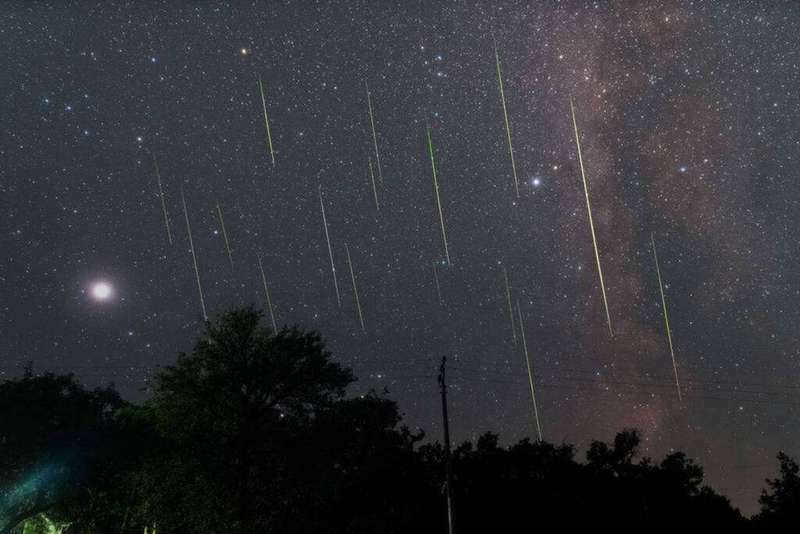

Throughout history, the mesmerizing night sky has captivated the human imagination. From ancient times, intellectuals from various cultures have embarked on a quest to comprehend our existence in the vastness of the Universe, attempting to visualize and rationalize its intricate structure. With the advancements in scientific knowledge, we have transitioned from romantic and religious interpretations to logically substantiated theories, supported by an abundance of empirical evidence obtained through extensive astronomical research. Consequently, even the youngest students now possess a rudimentary understanding of the latest findings regarding the appearance of our Galaxy, its celestial designation, and its projected future.
Etymology of the name
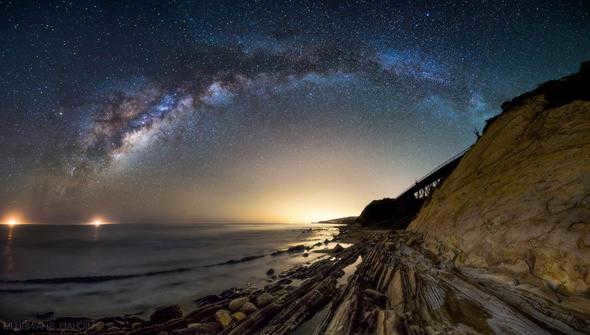
An internal perspective
The ancient Greeks did not contribute much to the scientific understanding of the structure of the part of the universe that encompasses the solar system. Over time, our comprehension of the appearance of our galaxy has progressed from Aristotle’s concept of a spherical universe to contemporary theories that account for black holes and dark matter.
However, determining the shape of our Galaxy is challenging due to the fact that Earth is a component of the Milky Way system. To obtain a definitive answer, an external viewpoint from a significant distance is necessary. Unfortunately, current scientific capabilities do not afford us this opportunity. Instead, scientists rely on gathering data on the structure of the Galaxy and comparing it with the parameters of other cosmic systems that are accessible for study.
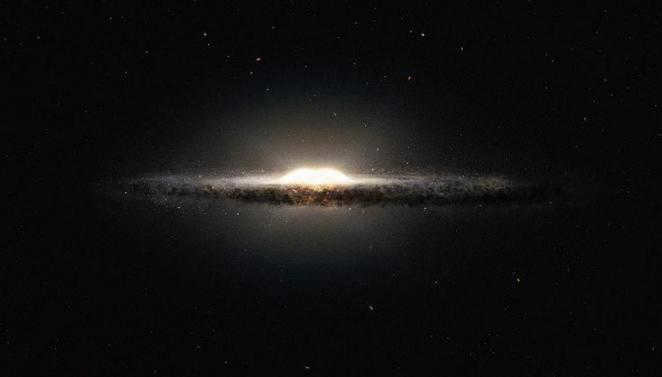
Based on the information gathered, we can confidently state that the center of our Milky Way galaxy is located in a constellation. It takes the form of a disk with a thickening in the middle, known as a bulge, and it also has spiral arms that branch out from the central region. These spiral arms are home to the most luminous stars in the galaxy. The diameter of the disk is greater than 100,000 light-years.
Structure
The arrangement of the Galaxy is concealed by interstellar dust, posing challenges to its study. Radio astronomy techniques aid in overcoming this obstacle. Waves of specific wavelengths can easily penetrate through barriers and provide the desired image. Our Galaxy exhibits a diverse structure, according to the available data.
Broadly speaking, two interconnected components can be distinguished: the halo and the disk proper. The first subsystem possesses the following characteristics:
- It has a spherical shape;
- The bulge is considered its center;
- The middle part of the halo is where the highest concentration of stars is found, while the density diminishes significantly towards the edges;
- The rotation of this region of the galaxy is relatively slow;
- The majority of the halo is inhabited by aging stars that have relatively modest masses;
- A significant portion of the region within the galaxy is occupied by dark matter.
In terms of stellar density, the galactic disk surpasses the halo in size. The arms of the galaxy are home to young stars and even objects that are still in the process of formation.
The central hub and the essence
The focal point of the Milky Way can be found within the Sagittarius constellation. Exploring this region is crucial for gaining a comprehensive understanding of our galaxy. In scientific literature, the term “core” can either pertain solely to the central area with a diameter of a few parsecs, or encompass the bulge and gas ring, which are believed to be the birthplace of stars. For the purposes of this discussion, the former definition of the term will be utilized.
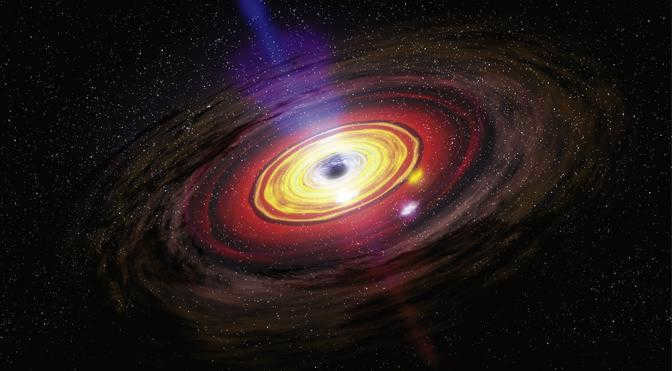 The center of the Milky Way is challenging to observe in visible light due to the presence of cosmic dust that obstructs our view of what our Galaxy looks like. However, astronomers have been able to gain valuable insights into the core by using infrared imaging techniques.
The center of the Milky Way is challenging to observe in visible light due to the presence of cosmic dust that obstructs our view of what our Galaxy looks like. However, astronomers have been able to gain valuable insights into the core by using infrared imaging techniques. 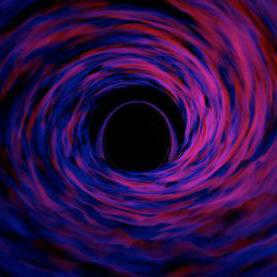
Scientists have been able to gather data on the unique characteristics of radiation in the central region of the Galaxy, which has led them to theorize the existence of a black hole at the core. This black hole is estimated to have a mass that exceeds 2.5 million times the mass of the Sun. Additionally, researchers believe that there is another, smaller black hole in orbit around this central object. This discovery aligns with our current understanding of the cosmos, as it is now believed that most galaxies have similar black holes located in their central regions.
Light and darkness
Black holes have a unique influence on the movement of stars, causing distinct alterations in the appearance of our Galaxy. These alterations manifest as unusual changes in orbits, particularly those near the solar system. Research into these trajectories and the correlation between velocity and distance from the galactic center has paved the way for the development of the dark matter theory, which is currently under active investigation. Despite its investigation, the true nature of dark matter remains a mystery. Its existence, however, is inferred from the gravitational effects it exerts on orbits and is believed to constitute the majority of matter in the Universe.
If we disperse all the cosmic particles that obscure the core from our view, an astonishing image reveals itself. Despite the abundance of dark matter, this region of the cosmos is teeming with the radiance emanating from an immense number of celestial bodies. There exist hundreds of times more stars per unit of volume than in the vicinity of our Sun. Approximately ten billion of these stars comprise a galactic bar, also referred to as a jumper, which possesses a rather irregular form.
A stellar shell
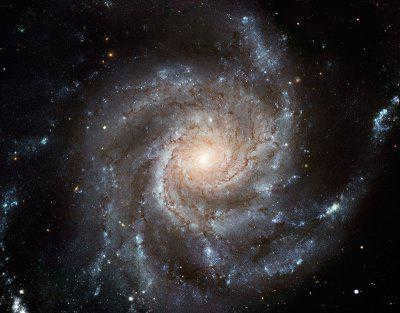
Infrared images have provided detailed information about the center of our galaxy. It has been discovered that the core of our galaxy has a structure that resembles a peanut inside a shell. This peanut-shaped structure is the lintel, which contains over 20 million red giants (bright stars that are not as hot). The spiral arms of the Milky Way extend from the ends of the bar.
The investigation into the finding of the “peanut” within the star system not only provided insight into the structural makeup of our Galaxy, but also contributed to our understanding of its evolutionary process. At first, there was a conventional disk occupying the expanse of space, which gradually gave rise to a central bar. As internal mechanisms took effect, the bar underwent a transformation, resembling the shape of a walnut.
Our place in the vastness of the universe
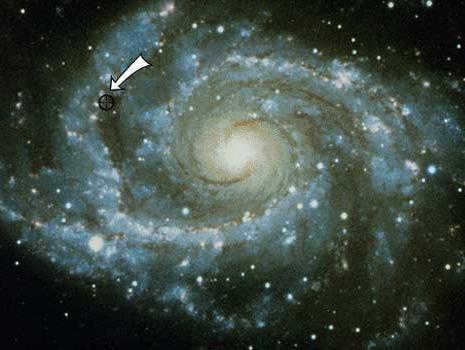
Active star formation occurs in both the central region and the spiral arms of our Galaxy. The spiral arms, which are named after the constellations they are found in – Perseus, Swan, Centaurus, Sagittarius, and Orion – have played a significant role in the development of our solar system. The Solar System, located near the Orion arm and at a distance of at least 28 thousand light-years from the core, possesses specific characteristics that experts believe have made the emergence of life on Earth possible.
The galaxy and our solar system both rotate together. The movements of the individual elements do not align. Some stars are occasionally part of the spiral branches, while others are separate from them. Only the stars located at the edge of the corotational circle do not go on such “journeys”. This group includes the Sun, which is shielded from the intense processes constantly occurring in the arms. Any slight deviation would nullify all other benefits for the evolution of organisms on Earth.
The sky filled with precious gems
The Sun is just one of the countless celestial bodies that populate our galaxy. There are over 400 billion stars, whether they exist individually or in clusters, as per the latest scientific findings. Proxima Centauri, the closest star to our solar system, is part of a three-star system, together with Alpha Centauri A and Alpha Centauri B, which are slightly further away. The brightest star in the night sky, Sirius A, can be found in the constellation known as Canis Major, or the Big Dog. Its luminosity is estimated to be 17-23 times greater than that of our Sun, depending on various sources. Sirius is not alone in the sky, as it has a companion star with a similar name, designated as Sirius B.
Children often start to learn about the appearance of our Galaxy by looking up at the sky and searching for Polaris or Alpha Minor Bear. Its popularity stems from its location above Earth’s North Pole. Polaris is significantly brighter than Sirius (almost two thousand times brighter than the Sun), but it cannot compete with Alpha Canis Majoris for the title of the brightest star due to its distance from Earth (estimated to be 300 to 465 light years away).
Categories of celestial bodies
Celestial bodies vary not only in their luminosity and distance from the observer. Each one is assigned a specific magnitude (with the Sun’s parameter serving as a reference point), level of surface heating, and color.
Supergiants possess the most impressive sizes among celestial bodies. Neutron stars, on the other hand, have the highest concentration of matter per unit volume. The color of a celestial body is closely linked to its temperature:
- The coldest celestial bodies appear red.
- A surface temperature of 6,000º produces a yellow hue, similar to that of the Sun.
- Celestial bodies that appear white or blue have temperatures exceeding 10,000º.
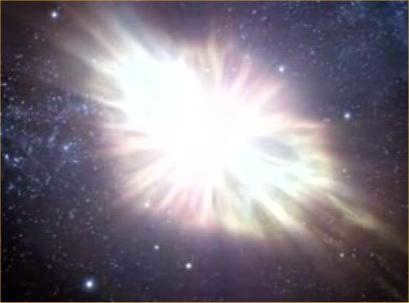
The brightness of a star can change and reach a peak just before its collapse. Supernova bursts provide valuable insights into the appearance of our Milky Way. Images captured by telescopes during this phenomenon are truly impressive.
The information obtained from these images has aided in understanding the sequence of events leading to the eruption and in making predictions about the destiny of various celestial bodies.
The future of the Milky Way
Our Galaxy and other galaxies are constantly in motion and interacting. Scientists have determined that the Milky Way has repeatedly absorbed its neighboring galaxies. Similar processes are anticipated in the coming years. Eventually, it will incorporate the Magellanic Cloud and several other dwarf systems. The most awe-inspiring event is projected to occur in 3-5 billion years. This will involve a collision with the Andromeda Nebula, the only neighboring galaxy visible to the naked eye from Earth. As a result, the Milky Way will transform into an elliptical galaxy.
The vastness of outer space is mind-boggling. It is challenging for the average person to comprehend the enormity of not just the Milky Way or the entire Universe, but even our own planet Earth. However, thanks to scientific advancements, we are able to somewhat grasp the magnitude of the magnificent world we are a part of.
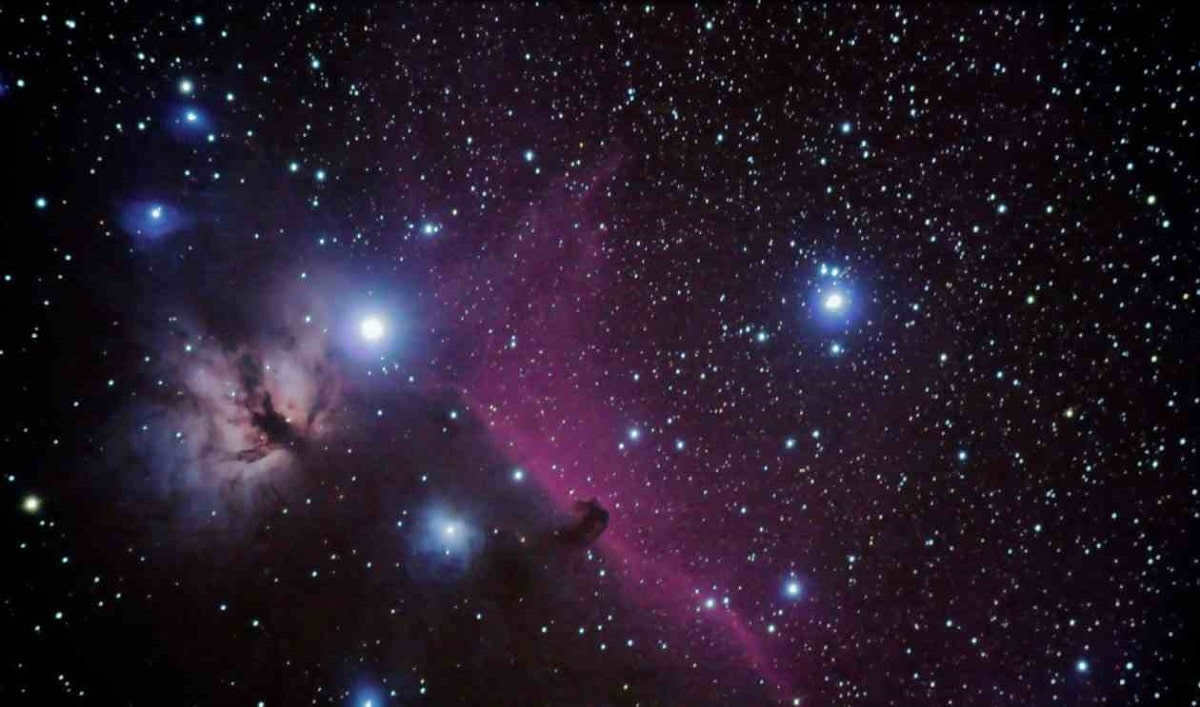
A galaxy is a vast collection of stars that tend to come together due to the gravitational attraction they have for one another. In the case of our planet and the solar system, we are relatively close to the Milky Way, a spiral galaxy that is commonly found in the known universe. Because we reside in the outer arm of the Milky Way, which is millions of light-years away from its core, life as we know it is able to thrive on Earth. In the central regions of galaxies, the stars are so densely packed that the gravitational forces they exert on each other create immense pressure, making it impossible for life to exist in the same way we are familiar with. However, there exist other galaxies that are peculiar and incredibly intriguing.
Let’s explore the most peculiar and captivating galaxies in the vast universe and delve into their unique features.
Unveiling the Most Bizarre Galaxies in the Universe
NGC 474
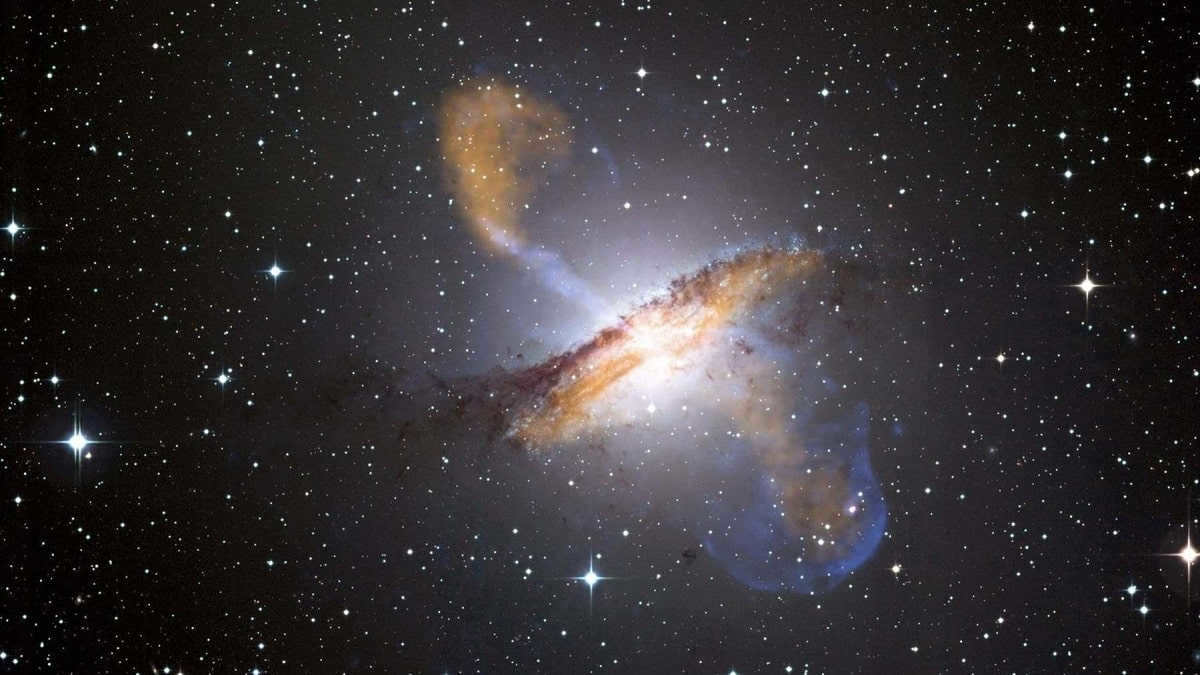
The center of NGC 474 can be found in the South Pisces constellation. It is positioned around 98 million light-years away from our planet. This galaxy is classified as an elliptical galaxy, which means its shape is mainly spheroidal or ellipsoidal rather than being disk-shaped like spiral galaxies. The ellipticity of NGC 474 suggests that its stellar composition is evenly distributed in all directions and lacks a distinct arm or disk structure.
NGC 474 has an estimated diameter of approximately 120,000 light-years, making it quite large in size.
In its central region, the galaxy exhibits interesting characteristics in addition to its elliptical shape. Detailed observations have unveiled the presence of “radio ejecta” at the core, indicating that NGC 474 may have undergone supermassive black hole activity in the past. This activity would have resulted in the emission of material at high velocities in the form of particle and energy jets.
When it comes to the stellar population, NGC 474 boasts a diverse mix of stars with varying ages and chemical compositions. Typically, elliptical galaxies have older stellar populations due to the decline in star formation compared to more active spiral galaxies. However, it is also possible to find young star clusters in the outer regions of NGC 474.
NGC 474 belongs to a cluster of galaxies known as the NGC 470 group, which comprises several neighboring galaxies that are gravitationally interacting with each other. This interaction might have influenced the current structure and observed characteristics of NGC 474.
ESO 415-19.
Located approximately 450 million light-years away from Earth, ESO 415-19 exhibits similarities to other galaxies, but it also possesses unique attributes distinguishing it from the Milky Way. ESO 415-19 falls under the category of a “special spiral galaxy” due to the presence of long streams of stars extending away from its galactic core, resembling the arms of a peculiarly elongated spiral.
According to the European Space Agency (ESA), these “tidal inflows,” which are considered remnants or traces of galactic inversions, are the result of a chance interaction in the galaxy’s past, giving ESO 415-19 its distinctive appearance.
This characteristic makes this galaxy a significant target for Hubble, as its observations are a part of an ongoing campaign to explore some of the most unique and stunning galaxies in the Universe as a part of the Apu Atlas mission. This program allows us to discover pairs, triplets, and even quintets of interacting galaxies, including peculiarly isolated galaxies.
Specifically, this section of the celestial sphere is situated within the Fornax constellation, where the Hubble Ultra Deep Field observations were conducted. The telescope expended nearly one million seconds to capture an area encompassing approximately 10,000 galaxies with varying ages, dimensions, configurations, and hues.
Galaxy hat
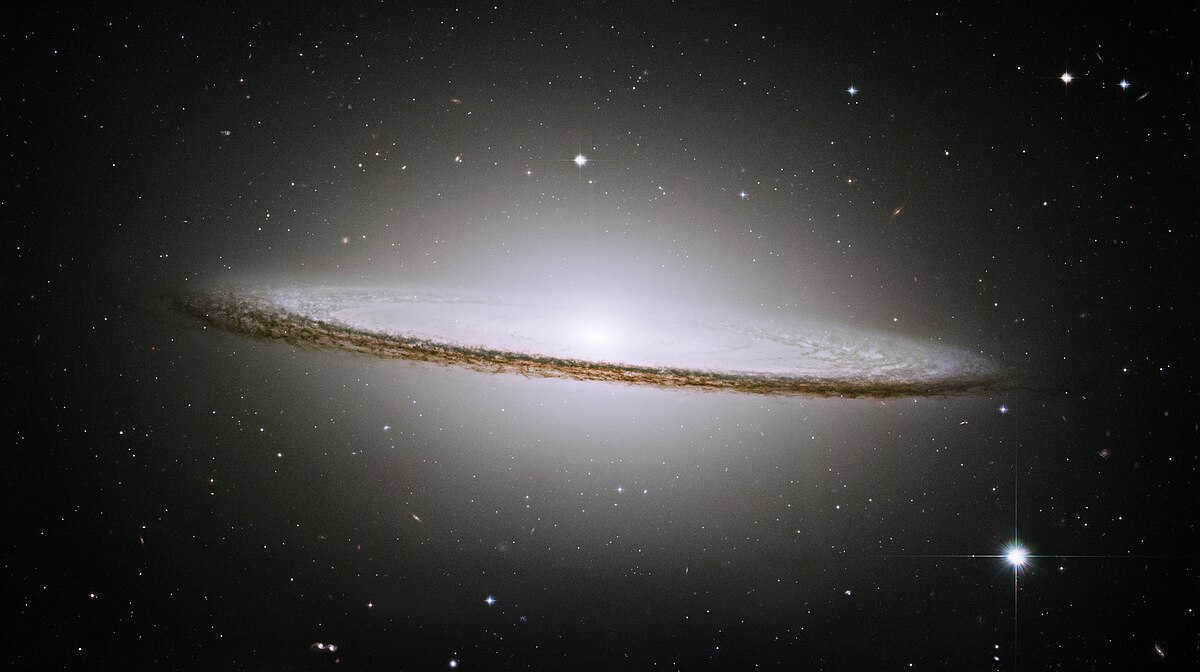
The Sombrero Galaxy, also called M104 or NGC 4594, is a spiral galaxy located in the constellation Virgo, approximately 28 million light-years away. This galaxy is highly notable and extensively studied due to its unique characteristics.
Its name originates from its distinctive shape, which closely resembles a wide-brimmed Mexican hat. The galaxy’s shape is the result of a central bright bulb combined with an outer spiral structure that features prominent spiral arms. Within these arms, there is a mix of young and old stars, contributing to the galaxy’s striking appearance.
A massive supermassive black hole occupies the central position. The estimated mass of this black hole is several billion times greater than that of our Sun, and it plays a critical role in shaping the dynamics of the galaxy. The gravitational pull exerted by this black hole governs the distribution of stars and gas within the galaxy’s core.
The Sombrero galaxy boasts significant amounts of gas and dust. These elements are essential for the formation of new stars, as they collapse under their own gravity, giving rise to dense regions referred to as star-forming regions. The existence of these star-forming regions within the Sombrero galaxy holds great significance in its evolutionary process.
The galaxy of guinea pigs
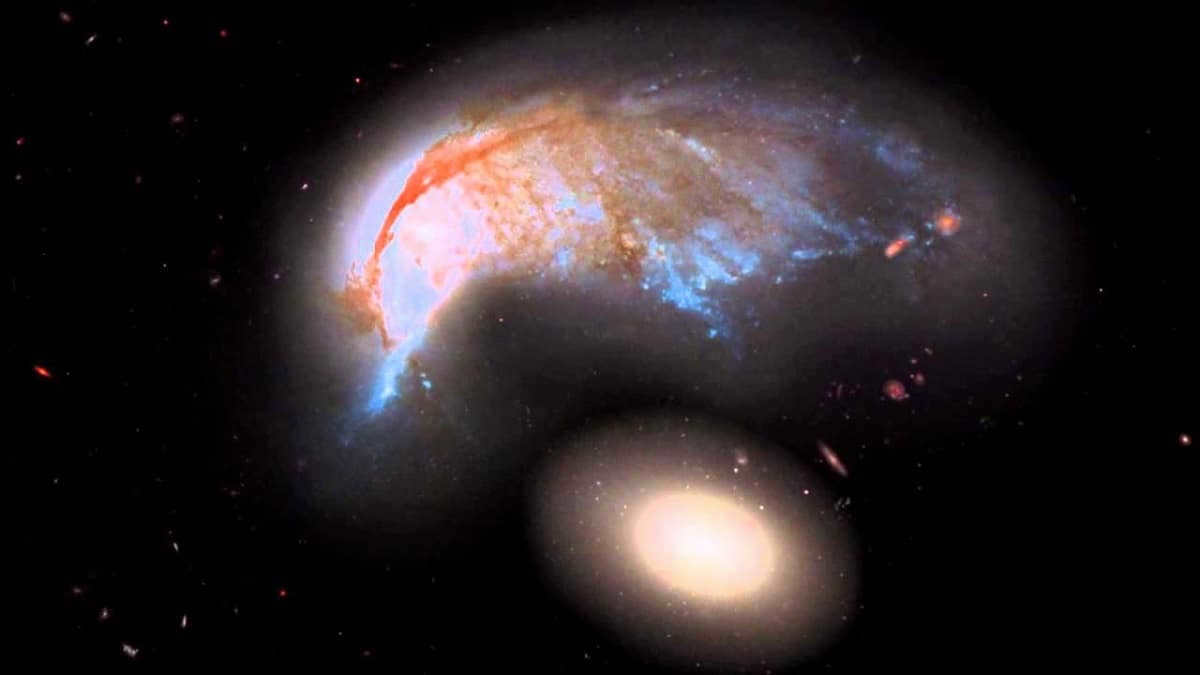
The porpoise galaxy is classified as a spiral galaxy due to its distinctive disk structure featuring curved arms.
Within its spiral arms, there is active star formation, contributing to the galaxy’s remarkable brightness across a range of wavelengths, including visible light, radio waves, and X-rays.
Located in the central region is a dense nucleus known as the galactic nucleus. Scientists believe that a supermassive black hole resides in this area, possessing a mass significantly greater than that of stellar black holes. The interaction between this black hole and the surrounding matter has significant repercussions for the dynamics and evolution of the entire galaxy.
By reading this information, you will have the opportunity to expand your knowledge about the most peculiar and captivating galaxies in the vastness of the universe.
This article adheres to our editorial ethics guidelines. If you spot any errors, please click here to report them.
Summary of the Full Article: Network meteorology " astronomy " The universe’s most unusual and captivating galaxies
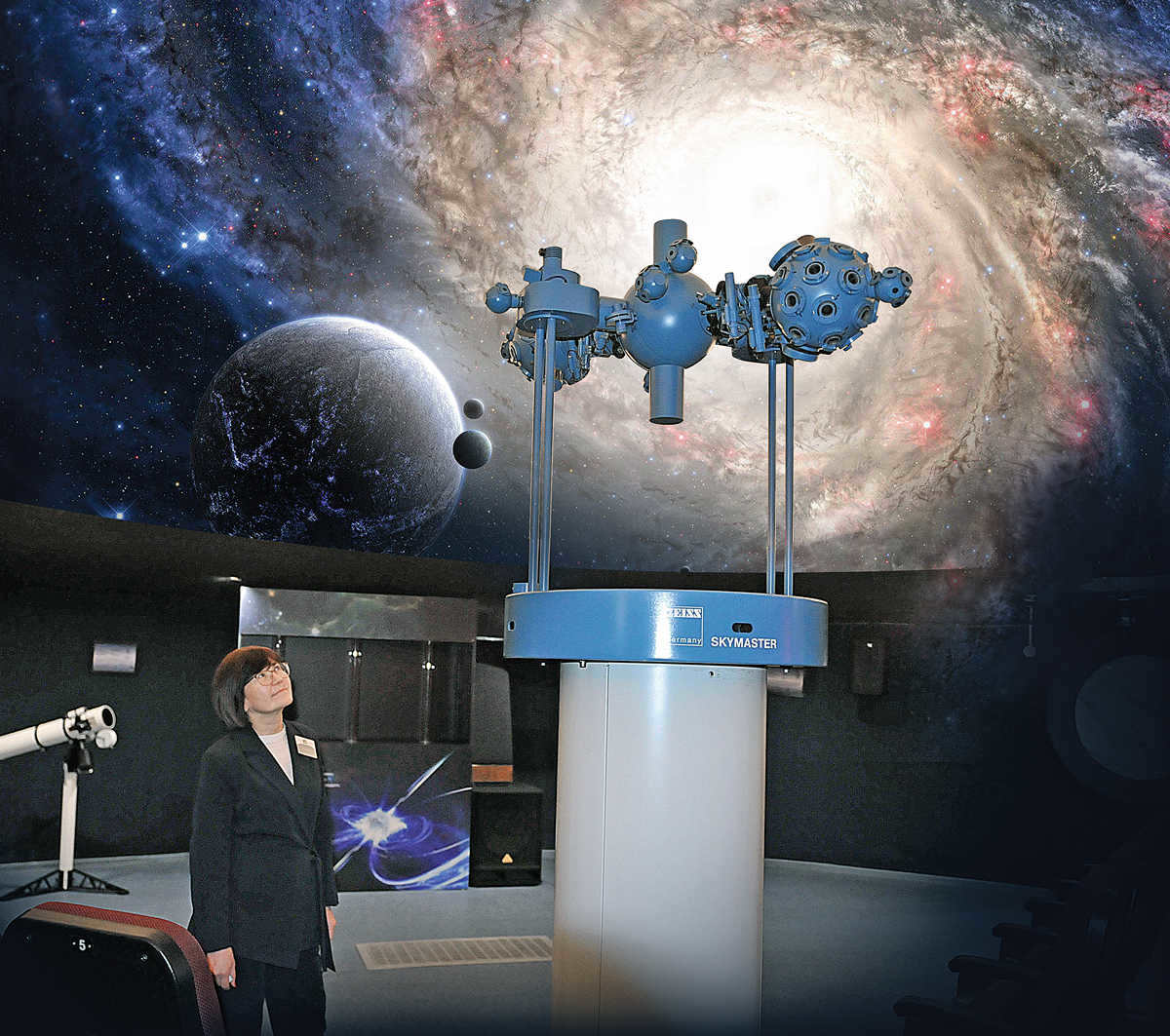
“I avert my gaze from the cursed individuals and allow darkness to descend upon the planet!
And an ominous event occurred. With each uttered word, the sun’s radiance diminished… By the final word, it transformed into a pitch-black disc surrounded by a ring of fire.
A collective cry erupted from numerous hearts…..
– Osiris! – Kherihor exclaimed from the terrace. – Reveal yourself to the sorrowful people.
Simultaneously, the darkness dispersed and the sun regained its former luminosity”.
In Bolesław Prus’s novel “Pharaoh,” the outcome of the duel between the Pharaoh and the priests was determined by a solar eclipse, favoring those who had been studying the sky for millennia. Throughout history, astronomy has played a crucial role in helping mankind accurately predict events such as the flooding of the Nile, the timing of sowing, and even maintaining social order.
Today, near space plays a pivotal role in various aspects of human life, and thanks to cutting-edge technology, we are able to explore and unravel the mysteries of distant constellations. However, it is worth noting that our nation has played a significant role in pioneering space exploration. This intriguing narrative is beautifully depicted in the new program titled “Space History of Russia” presented by the Association of Planetariums of the Russian Federation. For an immersive experience, head to the Ufa City Planetarium. For instance, did you know that in August 1957, the first successful test of the R-7 intercontinental ballistic missile took place? This groundbreaking event took place at the Tyuratam cosmodrome, which later became known as Baikonur, and the missile traveled all the way to Kamchatka, marking a momentous achievement. Furthermore, on October 4, 1957, the two-stage rocket R-7 made history by reaching the first-ever space velocity and successfully placing an artificial satellite into Earth’s orbit. Undoubtedly, the R-7 has emerged as one of the foremost rockets in its class worldwide, as it continues to soar through the skies even in its modern iterations.
In October 1959, Luna-3, an automatic station, successfully captured images of the lunar far side, marking a significant milestone in space exploration. The Soviet Union further cemented its place in history in 1966 when they achieved the first soft landing on the Moon. This remarkable feat was accomplished by our talented engineers who navigated the Zond-5 descent vehicle back to Earth, achieving speeds of over 11 kilometers per second. Notably, the spacecraft carried a group of Central Asian turtles, providing a unique perspective on this groundbreaking mission. The awe-inspiring views of the celestial bodies and the spacecraft itself, which will one day touch down and usher in a new era of space travel, highlight the vastness of the cosmos and humanity’s relentless pursuit to explore it.
– According to Elena Vetoshnikova, the program is incredibly stunning and educational. She was left in awe by what she witnessed in the star hall. Despite my extensive knowledge on the subject, having had a deep interest in astronomy and reading extensively about it during my youth, I still found this movie to be truly remarkable. I strongly believe that this film should be mandatory viewing for schoolchildren.
Interestingly, it appears that today’s audience consists of families with a longstanding fascination for space.
– Our children used to visit here every week when we lived nearby,” shares Katharina Fischer. – We even have a telescope at home, and some of the best moments of our lives were spent laying on mattresses on racks, sipping tea, and stargazing. This phenomenon is particularly mesmerizing when observed from the mountains…
What is the current state of the planetarium, which actively contributed to the development of this program? What else does it have to offer to the Ufa community?
Reach for the heavens
But before we delve into the details, let’s start by explaining what exactly a planetarium is. In our city, this magnificent structure emerged during the era of space romanticism in the 1950s and 1960s. The inaugural shows and lectures took place within its walls on July 22, 1964. The dome of the planetarium is designed to replicate the celestial sphere, and initially, its main purpose was to showcase the starry sky. To achieve this, all planetariums were equipped with state-of-the-art optical-mechanical devices. These apparatuses would create tiny points of light that beautifully mimicked the stars, while the “sky” itself could rotate and transform, further enhanced by captivating slides. In addition, video projectors were also utilized, although they functioned more like those found in traditional movie theaters, projecting their images onto a flat surface rather than encompassing the entire dome.
In 1995, the country’s first projection apparatus called “Skymaster” ZKP-3 was introduced in the star hall. This advanced technology created a scientifically accurate and visually stunning representation of the starry sky. The optical systems of the Skymaster provided exceptionally clear images of stars, the Sun, the Moon, and planets. As the new millennium arrived, Russia experienced a surge in digital projections. In 2014, the planetarium upgraded to a full-dome digital system featuring four synchronized video projectors. With this cutting-edge technology, the planetarium can now project not only the starry sky, but any image across the entire dome.
More than just a film
One of today’s accomplishments is the creation of a unique full-dome animation program called “Cosmic Dream of Whyte”. This program provides children with essential knowledge about the solar system in an engaging and interactive way. In addition, three more programs have been developed in collaboration with the Association of Planetariums of Russia. This highlights the importance of creating innovative and original products in all fields.
Azamat Rakhmangulov, the head of the planetarium’s development department, discusses the endless wonders of the cosmos that can be explored within the familiar dome of Gafuri Park. He also shares insights into the ongoing work on developing modern planetarium programs:
– The experience of being fully immersed in a dome-shaped program is much more intense than watching it on a regular flat screen. The challenge lies in the fact that this program is a genuine computer animation that features intricate and personal space objects – essentially, a full-fledged movie production. Achieving this requires a significant number of experts, expensive equipment for the calculations, and unfortunately, there is a limited availability of both funds and specialists. That is why we collaborate with colleagues from other cities, as there are around 60 planetariums in the country, with the most active ones being in Kaluga, Yaroslavl, and Nizhny Novgorod. Some of us are responsible for writing the script, others handle the visualization, editing, and even composing the music. The project “Space History of Russia,” for which we provided the visualization, was made possible with the support of the Presidential Fund for Cultural Initiatives. It is important to note that planetarium programs are not the same as movies, as they remain relevant for many years.
Currently, we are working on two more programs.
Anticipating the Explosion of a Supernova
– One of the novels I created is called “Star Wanderers”. Its protagonists are a young extraterrestrial and his robotic companion. Young readers will be able to identify with the inquisitive teenager who, by sheer luck, owns a spaceship, and the robot, who possesses encyclopedic knowledge, will enlighten them about the fascinating phenomena within our galaxy.
– Our galaxy, the Milky Way, is teeming with intriguing and unexplored wonders. What specific aspects would you like to learn more about?
– The script is currently in the process of being written. Did you know that all chemical elements are actually created through thermonuclear reactions deep within stars? (Of course, not every star is capable of this – it must be sufficiently massive.) The elements that come before iron on the periodic table are created through these reactions, releasing energy in the process. On the other hand, iron and the remaining elements are created through absorption, meaning they can only be formed during a supernova explosion. This phenomenon has already been observed by humanity: records of it can be found in the annals of Chinese astronomers dating back to 1054. In the constellation of Taurus, in an area where no stars were previously visible, a large bright star suddenly appeared – this was the result of a supernova explosion. The remnants of this explosion became the Crab Nebula, which happens to be one of the most breathtaking sights in the night sky. Additionally, a neutron star (known as a pulsar) was also formed – a small but incredibly dense celestial body.
Currently, preparations are underway for an impending explosion of the red supergiant Betelgeuse in the Orion constellation. This celestial event is expected to occur within the next 100,000 years. If humanity is fortunate enough to witness this extraordinary occurrence, we will be able to observe a colossal star in the sky, comparable in size to the Moon. Remarkably, it will even be visible during daylight hours.
– Could this potentially pose a threat to Earth?
– It’s fascinating to note that the discovery of numerous exoplanets has been made possible today, thanks to the Kepler and Hubble telescopes. Furthermore, in 2021, the “James Webb” telescope, an orbital infrared observatory, was launched. Positioned at a distance of 1.5 million kilometers from Earth, this telescope benefits from the absence of atmospheric interference, resulting in a resolution that is 7-10 times superior to that of ground-based telescopes. Consequently, mankind now has the unprecedented opportunity to perform spectral analysis on exoplanet atmospheres. Some of these exoplanets orbit at an optimal distance from their star, allowing for the potential presence of water on their surfaces. For life to thrive on a planet, it must be located within the habitable zone, which varies depending on the luminosity and temperature of each star. Remarkably, we have already identified a considerable number of candidates that exist within these habitable zones.
By utilizing spectral analysis, we can accurately determine the chemical makeup of an exoplanet’s atmosphere. If there are detectable amounts of methane, or even better, biomarkers like chlorophyll, we can confidently infer the presence of life with a 100% probability.
– Isn’t the presence of oxygen a marker as well?
– No, it isn’t. There could be life forms on an exoplanet that do not rely on oxygen for their metabolic processes. In fact, life on Earth initially began with anaerobic bacteria that utilized chemosynthesis instead of oxygen. Subsequently, blue-green algae emerged and, through their metabolic activities, released oxygen, gradually saturating the Earth’s atmosphere. Therefore, life forms on Earth are essentially a result of the biological contamination of the atmosphere with oxygen.
Certainly, the majority of our programs typically focus on providing general education and do not delve into complex subjects. However, the Galaxy offers a myriad of fascinating elements even without delving into those complexities. One such element is its spiral shape, with a supermassive black hole residing at its center. Hence, there is an abundance of captivating information to share!
Earth Day – a daily commitment
– Are your programs dedicated solely to outer space or do they also cover various fascinating phenomena occurring on Earth? Do you address the problems and dangers that pose a threat to both people and the planet?
– Absolutely. Take, for instance, the program “The Enigmatic Secrets of Trees” which sheds light on the pivotal role of plants in the biosphere, emphasizing the significance of photosynthesis. Furthermore, our program “The Unyielding Planet” delves into the intricate structure of our planet, exploring the movement of lithospheric plates, which serves as the catalyst for natural catastrophes such as volcanic eruptions, earthquakes, and tsunamis.
On Earth Day, we participate in a global initiative to conserve electricity by turning off our lights for one hour. During this time, we offer a free screening of the film “Home to Date the Planet”. This thought-provoking documentary explores the impact of human activity on our planet, with a particular focus on the pressing issue of global warming. Jan Arthus-Bertrand, an acclaimed photographer who has spent years capturing stunning aerial images of Earth from a hot air balloon, directed the film. His extensive collection of photographs, spanning several decades, serves as a powerful visual record of our planet’s degradation. As Arthus-Bertrand meticulously stitched together these images for his documentary, he could not ignore the undeniable evidence of the deteriorating biosphere and the detrimental effects of human intervention. Through his film, Arthus-Bertrand passionately raises awareness about this urgent problem.
– Have you also discussed the potential risks associated with asteroid impacts?
– Besides our programs, we also offer lectures. Our lecturer, Filipp Terekhov, is a well-known advocate for the field of cosmonautics, and he runs his own YouTube channel. Last year, we hosted a monthly event called Space Hour, where he discussed various issues in space, including the potential threat of asteroids. These lectures always drew in large crowds, and we even streamed them online and aired them on the PRO.Culture.RF channel.
However, at the moment, our lecturer is currently serving in the military. We eagerly await his return and wish him victory.
The sun in the palm of your hand
– Are there many people today who are interested in astronomy and space exploration?
– There has been a significant increase in interest in astronomy, which is evident from the numerous inquiries we receive from our residents who want to observe celestial bodies through a telescope, – says Anna Petrova, the director of the planetarium. – Moon and Sun observations are conducted on Saturdays from 11:00 am to 1:00 pm, but only when the weather is favorable, which typically happens during the warmer months. We have a Coronado solar telescope equipped with a special filter. Through this telescope, you can see prominences in the shape of loops on the surface of the Sun, as well as sunspots, which appear as small dots. However, an expert would know that these seemingly small dots are actually larger than our Earth. All of this is truly awe-inspiring and even serves as a source of inspiration.
There are numerous parents and children who visit us and have a keen interest in space. On weekends, our place is always packed. A lot of them come using the Pushkin map. However, a planetarium with only 60 seats is insufficient for a city with a population of one million.
An Unusual Allure from Outer Space
– However, here’s an unexpected question: why is it essential for every individual to have knowledge about the universe? After all, anything that captures our curiosity can be learned from the Internet…
People will forever have a thirst for knowledge, and not just limited to the vastness of the universe above. Knowledge is what defines us and gives us the tools to navigate through life, both as individuals and as a society. Exploring space is an integral part of our understanding of the world, shaping our scientific perspective, expanding our horizons, fueling our curiosity for further knowledge, sparking creativity and innovation, and establishing true values and moral compasses. The human spirit has always been driven by the desire to explore uncharted territories and discover new worlds. However, it is important to acknowledge that in today’s world, there are many individuals who lack sufficient knowledge and can be easily swayed by misinformation.
Interestingly, even primitive hunters possessed the skill of navigating through space using the stars. So, why should modern humans be any less capable? We too can learn this ancient art. In each of our programs, you will have the opportunity to learn how to locate the Big Dipper and Polaris in the night sky.

